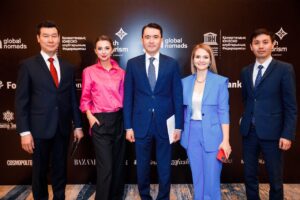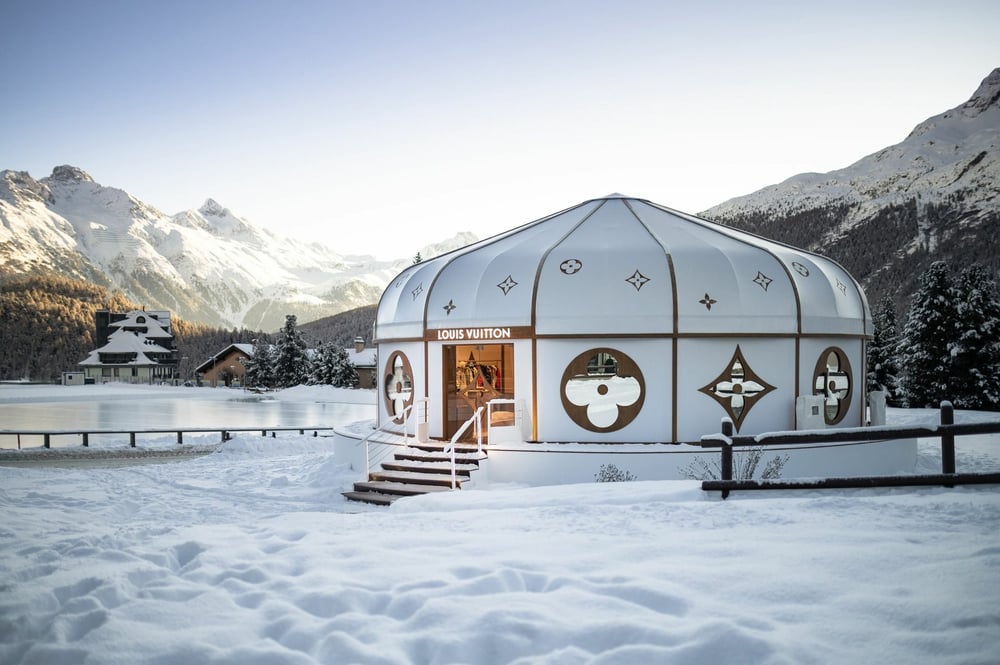ASTANA – There are three postulates for creative industries development – a high level of education, state support, and freedom of speech, said Irina Kharitonova, the research expert on cultural and creative industries in Central Asia, the Commonwealth of Independent States (CIS), and Europe. In an interview with The Astana Times, she explained why Kazakhstan is becoming an attraction point for creators, addressed nomadism in modern interpretation, and reviewed international practice in strengthening the creative economy.

Yernar Kurmashev, Timur Bekmambetov, Irina Kharitonova, Ernist Umetaliyev, and Olzhas Baimagambetov after the Digital Bridge panel session on the impact of artificial intelligence (AI) on creative industries. Photo credit: Kharitonova.
Last year, Kazakhstan introduced the concepts of creative activity and creative industries by amending the Law on Culture and the Entrepreneurial Code. Creative industries are now considered part of the country’s private business sector, requiring state support. In his state-of-the-nation address, President Kassym-Jomart Tokayev also devoted attention to the development of the creative industry, tasking the government to create all conditions for it to thrive.
Latest developments in Kazakhstan’s creative industries
In June, the Kazakh Ministry of Tourism and Sports (the former Kazakh Ministry of Culture and Sports) presented a list of 43 creative activities, including cinema, animation, contemporary art, jewelry, IT and game development, television programs, photography, architecture and fashion, music, and cultural heritage.

Kazakh Tourism Board Chair Kairat Sadvakasov, Irina Kharitonova, Vice Minister of Tourism and Sports Yerzhan Yerkinbayev, Global Nomads Brand Director Inna Apenko, Kazakh Tourism Managing Director Daniel Serzhanuly. Photo credit: Kharitonova.
Kazakhstan pursues its cultural policy under the concept of creative industries development for 2021-2025, which was adopted to generate employment in technological and venture entrepreneurship with a focus on the younger generation.

In 2000s, Kharitonova launched her first collection of dresses with the storytelling on Kazakh culture. The clothing was made of recycled plastic. Photo credit: Alexey Baranov.
This year, the Kazakh Tourism national company and Almaty Management University (AlmaU) launched the first master’s program in creative industries management.
“Kazakhstan should raise professionals to comprehensively develop the country’s creative industries. The key idea of the creative economy is to monetize talents, to turn creative units into commercial communities,” said Kharitonova.
In her view, it will also increase investment attractiveness. “Investors will be more motivated to support creative projects in Kazakhstan,” she noted.
Kazakhstan is now constructing its first Museum of Arts in Almaty on the corner of the city’s two main highways – Al-Farabi and Nazarbayev. It will present world–class art to Kazakh people and showcase the works of the country’s art professionals.
The construction of the museum is funded by the Nurlan Smagulov Foundation with the support of the London-based Chapman Taylor architectural bureau and the Lord Cultural Resources global cultural consulting practice. Its opening is scheduled for next fall.

Salehe Bembury and New Balance 574 Yurt. Photo credit: nicekicks.com.
“We have many public cultural facilities, including theaters, libraries, and museums. From time to time, it would be great to transform these spaces into creative platforms to generate up-to-date cultural content and engage the public,” said Kharitonova.
“The state should ensure art spaces are not temporary, but permanent, and maintained together with the creators. For creators, live communication is pivotal – many collaborative ideas emerge in real art spaces,” she added.
The domestic IT community is growing not only in Astana and Almaty but also in Karagandy, the Kazakh city of mine workers. The Terricon Valley project, which was initiated by the city’s residents, provides space for the development of tech startups, collaboration, educational training, and creative events. The IT hub has been transformed into a rapidly expanding networking platform for digital creators. It plans to attract 10,000 professionals in the next five years.
“Every city should have an attraction point, a major feature of its creative cluster. Earlier, Terricon Valley united only IT specialists. Now, with the development of digital art, artists are much more involved in digital activities, and take part in respective projects,” she said.
On the first day of the recently held Digital Bridge forum in Astana, the Oct. 12 panel session gathered experts to address the impact of artificial intelligence (AI) on creative industries. The discussions moderated by Kharitonova showcased the necessity of the sector’s comprehensive development amid ongoing digitalization and globalization.
Nomadism of a new time
In September, Kazakhstan participated at the Contemporary Istanbul Art Fair in Türkiye for the first time. Nomadism was the key topic of the country’s exhibition stand. Amid globalization, the term “nomadism” is being popularized not only in tourism but in contemporary art. People in Central Asia historically have led a nomadic way of life.

Louis Vuitton pop-up store in the Swiss city of St.Moritz. Photo credit: us.fashionnetwork.com.
“Nomadism is our unique code, which gives an unlimited opportunity for creativity and attracts the interest of other countries. This is an interesting topic for the international art community. When I began to explore the origins of nomadism, I realized that nomads did care about the planet’s ecology. They had a friendly attitude towards people, and a big respect for the environment,” she said.
Kharitonova emphasized that the Kazakh steppes have historically provided boundless spaces for creativity.
“Even now, Kazakh artists are not afraid to raise politically and socially important trends in music, art, cinema, or design. Their ideas always resonate with the broader audience,” she said.
Speaking about the popularization of nomadism, Kharitonova shared two unique cases from the foreign fashion industry.
In 2021, Salehe Bembury, a footwear designer from the United States, teamed up with New Balance, the U.S. well-known footwear company, and designed a new model – Yurt 574. Its peculiarity lies in the word “yurt” written on the sneakers, which symbolizes round tents traditionally used as a dwelling by Central Asian nomads. Bembury is best known for his collaborations on luxurious streetwear with the Moncler, Crocs, Yeezy, and Versace fashion brands.
“There is an unusual whistle on the sneakers. The advertising company, which became so popular later, filmed our nomad yurt in the background,” noted Kharitonova.
In December 2022, Louis Vuitton launched a yurt-shaped pop-up store for the winter season in the Swiss city of St. Moritz. The French luxury fashion house used the combination of glass and wood to create a traditional nomadic architecture with modern elements. The decorations on the ceiling look like uyk, the top half of the yurt, and the design of the windows reminds kerege, its folding walls.
Regional and international outlook
Addressing the progress of the creative industries development in neighboring countries, Kharitonova noted that Uzbekistan shows great support for handicrafts and contemporary art.

The project of the future Museum of Arts in Almaty. Photo credit: almatymuseumofarts.org.
She mentioned that the works of Uzbek artists are now exhibited in the Louvre Museum.
In November last year, Uzbek President Shavkat Mirziyoyev and French President Emmanuel Macron opened the first exhibition from Central Asia titled The Splendours of Uzbekistan’s Oases in the Louvre Museum in Paris. It encompasses nearly 180 works – manuscript paintings, architectural traces, and monumental fragments from the Uzbek cities of Samarkand and Bukhara.
“With the state support, creators in the Kyrgyz Republic launched a great initiative at the legislative level called the Park of creative industries,” said Kharitonova, addressing the country’s recent developments.

Irina Kharitonova during the Almaty Creative Week in 2022. Photo credit: Kharitonova.
The park represents a special tax regime for legal entities from 20 creative sectors that receive 90% of profits. Residents of the park are provided with opportunities to expand globally. Foreign citizens will also be able to become residents of the park in the long run.
“As for Russia, the government allocates a large grant program for the development of the creative industry. The country annually conducts the Russian Creative Week [referring to a professional festival gathering representatives of the country’s 16 creative industries]. It also has a special fund to support creative ideas [Presidential Foundation for Cultural Initiatives],” she said.
This year, the Russian Creative Week took place in the Republic of Sakha (Yakutia), Russia’s largest constituent entity. “Yakutia has a well-developed creative cluster. They are fostering not only creative industries, but the creative economy with the establishment of educational hubs,” said Kharitonova.
On top of that, Russia is now considering the adoption of the Law on Creative Industries. It is expected to increase the share of creative industries in the country’s economy from 2% to 7%.
Reflecting on a broader international experience, Kharitonova said that the leading country in terms of contribution to gross domestic product (GDP) in the creative industry remains the United Kingdom. She stressed that the country is the birthplace of the creative economy.
According to the U.K. Department for Culture, Media and Sport (DCMS), the creative industries sector contributed £109 billion (US$132 billion) to the country’s economy in 2021. In June, the DCMS press release announced the government’s plan to grow the creative industries by £50 billion (US$60 billion) and support a million more jobs by 2030, with £77 million (US$93 million) of new funding for the sector.
U.K. is also keen to share its creative industry expertise with Kazakhstan. The recently launched creative hub at the De Montfort University, named DMUKreative Hub, is one of the examples of how it helps Kazakhstan in this effort.
“Indonesia, for example, has the Ministry of Tourism and Creative Economy. This proves the close link between tourism and creative activities,” said Kharitonova.
In 2019, the Indonesian Ministry of Tourism was merged with the country’s Creative Economy Agency to develop world-class tourism destinations, conduct tourism-oriented marketing, and facilitate cooperation between inventors and investors.
“When tourists visit a new city, the very first thing they do is sightseeing. They go to the most popular cultural locations,” she said.
The expert emphasized the link between culture, art and tourism is incredibly powerful and can bring unexpected results.
Kazakhstan’s participation in top creative events abroad not only generates a large tourist influx, but also proves international interest for Kazakh traditionalism.


